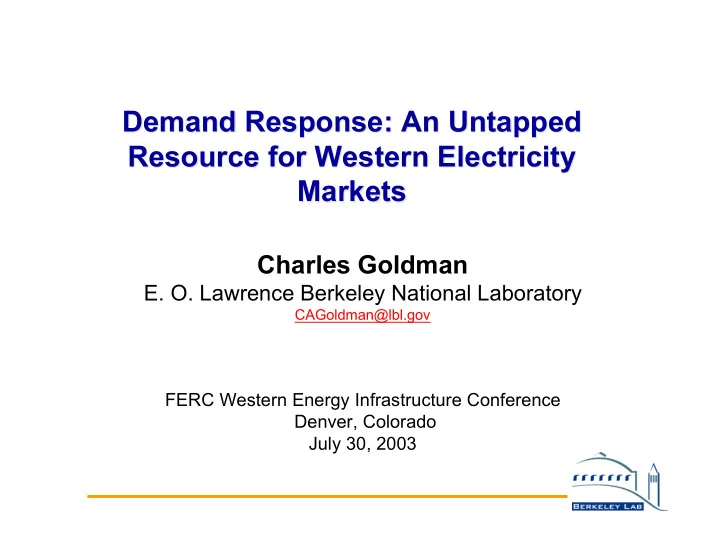

Demand Response: An Untapped Demand Response: An Untapped Resource for Western Electricity Resource for Western Electricity Markets Markets Charles Goldman E. O. Lawrence Berkeley National Laboratory CAGoldman@lbl.gov FERC Western Energy Infrastructure Conference Denver, Colorado July 30, 2003
Demand Response Resources Demand Response Resources • Broad perspective needed to capture full value of demand-side for electricity markets - Short-term Load Management - Dynamic Pricing - Energy efficiency - Distributed Generation • All intentional modifications to electric consumption patterns of customers that are intended to modify the timing or quantity of customer demand and usage on power system Energy Analysis Department
Peak Demand Savings from Utility Peak Demand Savings from Utility DSM in the West DSM in the West 15,000 12,500 Peak MW Reduction 10,000 7,500 5,000 2,500 0 1997 1998 1999 2000 2001 Energy Efficiency Load Management (Actual) Load Management (Additional Available) Data Source: Energy Information Administration, Form EIA-861 Database. Energy Analysis Department
Significant cost-effective potential for Significant cost-effective potential for additional energy efficiency in the West additional energy efficiency in the West Region Potential California 1 9,500 MW cost effective potential for peak demand • savings by 2011 1,700-5,900 MW achievable, depending on funding • levels 3500 MW savings offsets 35% of forecast load • growth Southwest 2 Technical/economic potential for EE red uces • demand growth from 2.7% to 0.7% per year Reduce energy consumption in 2010 by 18% • (relative to business -as-usual) Northwest 3 3,200 aMW cost -effective potential by 2025 • Offsets 60% of demand growth • 1. Xenergy, “California’s Secret Energy Surplus: the P otential for Energy Efficiency 2. Southwest Energy Efficiency Project, “The New Mother Lode” 3. Northwest Power Planning Council Energy Analysis Department
PRELIMINARY Assessment Assessment of Cost-Effective of Cost-Effective PRELIMINARY Conservation Potential in Pacific NW (2025) Conservation Potential in Pacific NW (2025) 3500 Agricultural Sector - 25 aMW Non-DSI Industrial Sector - 350 aMW 3000 Commercial Sector Non-Building Measures - 300 2500 aMW HVAC & Window Efficiency Improvements - 200 aMW 2000 New Commercial Building Lighting - 200 aMW Existing Commercial Buildings Lighting - 250 aMW 1500 Residential Space Conditioning - 575 aMW 1000 Residential Lighting - 660 aMW 500 Residential Water Heating - 335 aMW Residential Appliances - 305 aMW 0 Cost-Effective Potential (aMW in 2025) Source: NWPPC, 2003 Energy Analysis Department
What needs to be done to better utilize What needs to be done to better utilize demand response resources (DRR)? demand response resources (DRR)? • Resource Adequacy: Role and policies for DRR to compete fairly • Deploy and expand advanced metering • Short-term, “Emergency” Demand Response - States should set targets for LSEs - Develop strategy to transition legacy load mgmt programs - Set payments to reflect value of system reliability to customers Energy Analysis Department
What needs to be done (cont)? What needs to be done (cont)? • Energy Efficiency - EE resource potential can be most effectively captured through appliance/equipment standards, building codes, ratepayer-funded programs, and other policies/strategies - Utility/DISCO planning processes should consider all resource options to meet system needs - Establish or increase ratepayer or system benefit funds to implement cost-effective EE programs - Consider establish EE performance standards (TX) - Address ratemaking disincentives to utilities and/or consider other entities to administer EE programs Energy Analysis Department
Is DR becoming a stranded resource? Is DR becoming a stranded resource? Interruptible and Direct Load Control by NERC Region 8% 1998 7% 2002 6% % of Peak Load 5% 4% 3% 2% 1% 0% MAIN MAPP SPP ECAR NPCC SERC FRCC MAAC ERCOT WSCC Energy Analysis Department
Background Slides Background Slides Energy Analysis Department
Peak Demand Savings from Energy Peak Demand Savings from Energy Efficiency in California Efficiency in California 12,000 10,000 8,000 6,000 4,000 2,000 1975 1980 1985 1990 1995 2000 Energy Analysis Department
CA Energy Efficiency: Achievable Potential CA Energy Efficiency: Achievable Potential Energy Efficiency Achievable Potential at Two Times Current Program Funding Total Peak Demand Reduction = 3,500 MW in 2011 Compressed Air 1% Clothes Washer Office Equipment Air Conditioning 1% 2% 48% Pool Pump 2% Industrial Processes 3% Industrial Motors 3% Other 2% Refrigeration Lighting 5% Source: Xenergy, 2002 33% • Energy Efficiency savings offset 35% of growth in peak demand Energy Analysis Department
CA Load Growth under Alternate Energy CA Load Growth under Alternate Energy Efficiency Program Funding Scenarios Efficiency Program Funding Scenarios sSource: Xenergy, 2002 Energy Analysis Department
Electricity Supply Resource Mix in the Electricity Supply Resource Mix in the Pacific Northwest (2000) Pacific Northwest (2000) Other Gas Nuclear Petroleum 1.3% 7.8% 3.9% 0.4% Conservation 10.2% Coal 13.3% Hydro 63.9% Conservation savings of 2600 aMW in Pacific Northwest (1980-2000) Source: NWPPC, 2003 Energy Analysis Department
Energy Efficiency Savings in the Pacific Energy Efficiency Savings in the Pacific Northwest: 20 Years of Progress Northwest: 20 Years of Progress 3,000 Since 1980 Utility & BPA Programs, Since 1980 Utility & BPA Programs, Average Megawatts 2,500 Energy Codes & Federal Efficiency Energy Codes & Federal Efficiency Standards Have Produced Over Standards Have Produced Over 2,000 2600 aMW of Savings. 2600 aMW of Savings. 1,500 1,000 500 0 1980 1982 1984 1986 1988 1990 1992 1994 1996 1998 2000 BPA and Utility Programs State Codes & Federal Standards Source: NWPPC, 2003 Energy Analysis Department
Recommend
More recommend